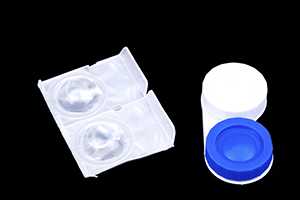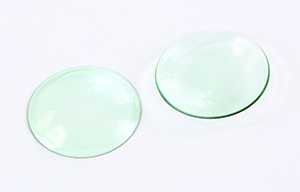Contact Lens Types
There are many different contact lens types available, all of which require a prescription from an eye care provider. Talk to your eye care provider if you’re thinking about getting contact lenses or changing your contact lens type. To get a prescription for contact lenses, an eye care provider will:
- Perform a complete examination of your eyes
- Try contact lenses on your eyes
- Determine how the contact lenses fit on your eyes
- Test your vision through the contact lenses
- Give you instructions on proper contact lens wear and care
Your eye care provider will help you get the best possible vision and comfort from contact lenses. Wearing contact lenses without a proper fitting and lens care instructions from an eye care provider can lead to eye injury, infection, or other complications 1,2. Contact lens types may differ based on what they are made from (lens material), how long they are designed for wearing each day (wear schedule), and how often they should be replaced (replacement schedule). The most common contact lens types include the following:
Lens Material: Soft or Hard (Rigid Gas Permeable)
Wear Schedule: Daily Wear or Extended Wear
Replacement Schedule (for soft contact lenses): Daily Disposable or Planned Replacement
Less commonly, people wear other types of contact lenses for special reasons.
Soft

Soft contact lenses are made of soft, flexible plastics that allow oxygen to pass through to the cornea—the clear dome that covers the colored part of the eye. This lens material may be easier to adjust to and provide better initial comfort than hard, or rigid gas permeable, contact lenses. Soft contact lenses are the most common lens material worn.
Hard, or Rigid Gas Permeable (RGP)

Hard, or rigid gas permeable (RGP), contact lenses are more durable than soft contact lenses and are resistant to buildup of eye-produced deposits on the lens surface. Hard contact lenses generally provide clearer, crisper vision. They also tend to be less expensive over the life of the lens since they last longer than soft contact lenses. Hard contact lenses are easier to handle and less likely to tear. However, they may take a longer period of time to adjust to as compared to soft contact lenses. They also require a more complex cleaning and disinfection process than soft contact lenses.
Daily Wear
Daily wear contact lenses are intended for use during the day. They are not designed for overnight wear. Remove daily wear contact lenses each night, rub and rinse with contact lens solution, and place in a clean contact lens storage case filled with fresh contact lens solution to disinfect them. Sleeping in daily wear contact lenses can increase the chances of getting a serious eye infection 1-4.
References
- Stapleton F, Keay L, Edwards K, Naduvilath T, Dart JK, Brian G, Holden BA. The incidence of contact lens-related microbial keratitis in Australia. Ophthalmology. 2008;115(10):1655-62.
- Dart JK, Radford CF, Minassian D, Verma S, Stapleton F. Risk factors for microbial keratitis with contemporary contact lenses: a case-control study. Ophthalmology. 2008;115(10):1647-54, 1654 e1-3.
- Poggio EC, Glynn RJ, Schein OD, Seddon JM, Shannon MJ, Scardino VA, Kenyon KR. The incidence of ulcerative keratitis among users of daily-wear and extended-wear soft contact lenses. N Engl J Med. 1989;321:779-83.
- Schein OD, Glynn RJ, Poggio EC, Seddon JM, Kenyon KR. The relative risk of ulcerative keratitis among users of daily-wear and extended-wear soft contact lenses. A case control study. Microbial Keratitis Study Group. N Engl J Med. 1989;321:773-78.
Extended Wear
Extended wear contact lenses are available for overnight wear ranging from one to six nights or up to 30 days. Extended wear contact lenses are usually made of soft plastics that allow more oxygen to pass through to the cornea. There are also a few brands of hard contact lenses designed and approved for overnight wear 1. Length of continuous wear depends on the contact lens type and your eye care provider’s evaluation of your tolerance for overnight wear. It’s important for the eyes to have a rest without lenses for at least one night following each scheduled removal 1. Talk with your eye care provider before considering this option, as overnight contact lens wear has been linked to serious eye infections 2-5.
References
- FDA. Types of Contact Lenses. 2013.
- Stapleton F, Keay L, Edwards K, Naduvilath T, Dart JK, Brian G, Holden BA. The incidence of contact lens-related microbial keratitis in Australia. Ophthalmology. 2008;115(10):1655-62.
- Dart JK, Radford CF, Minassian D, Verma S, Stapleton F. Risk factors for microbial keratitis with contemporary contact lenses: a case-control study. Ophthalmology. 2008;115(10):1647-54, 1654 e1-3.
- Poggio EC, Glynn RJ, Schein OD, Seddon JM, Shannon MJ, Scardino VA, Kenyon KR. The incidence of ulcerative keratitis among users of daily-wear and extended-wear soft contact lenses. N Engl J Med. 1989;321:779-83.
- Schein OD, Glynn RJ, Poggio EC, Seddon JM, Kenyon KR. The relative risk of ulcerative keratitis among users of daily-wear and extended-wear soft contact lenses. A case control study. Microbial Keratitis Study Group. N Engl J Med. 1989;321:773-78.
Daily Disposable
Disposable contact lenses—as defined by the U.S. Food and Drug Administration (FDA)—are used once and then thrown away 1. With a true daily disposable schedule, a brand new pair of lenses is used each day. Wearing daily disposable contact lenses for more than one day may cause eye discomfort or other complications 2,3. Discard daily disposable contact lenses at the end of each day, and put in a new pair the next day.
References
- FDA. Types of Contact Lenses. 2013.
- Dumbleton KA, Richter D, Woods CA, Aakre BM, Plowright A, Morgan PB, Jones LW. A multi-country assessment of compliance with daily disposable contact lens wear. Cont Lens Anterior Eye. 2013;36(6):304-12.
- Dumbleton K, Richter D, Bergenske P, Jones LW. Compliance with lens replacement and the interval between eye examinations. Optom Vis Sci. 2013;90(4):351-58.
Planned Replacement
Some soft contact lenses are labeled as "disposable," but they may be removed nightly and re-worn for multiple days. Replacement schedules for these contact lenses can vary from seven to 30 days. Talk to your eye care provider about the proper schedule for replacing your specific type of contact lens. Follow these tips to clean, disinfect, and store your contact lenses each time you remove them. Replace your contact lenses as often as your eye care provider tells you. Wearing contact lenses longer than the recommended replacement schedule can lead to eye discomfort or other complications 1,2.
References
- Dumbleton K, Woods C, Jones L, Richter D, Fonn D. Comfort and vision with silicone hydrogel lenses: effect of compliance. Optom Vis Sci. 2010;87(6):421-25.
- Dumbleton KA, Woods CA, Jones LW, Fonn D. The relationship between compliance with lens replacement and contact lens-related problems in silicone hydrogel wearers. Cont Lens Anterior Eye. 2011;34(5):216-22.
Hybrid
Hybrid contact lenses have a rigid gas-permeable center attached to an outer "skirt" made of soft contact lens material. The soft, outer part of the lens increases comfort and helps the lens to stay centered on the eye, while the rigid gas permeable center provides clear vision 1. This design is intended for people who have irregular corneas. Because this is a newer type of contact lens, there are fewer options available and fewer eye care providers who fit these contact lenses as compared to soft or hard contact lenses.
Reference
- National Keratoconus Foundation. Contact Lenses for KC. 2014
Orthokeratology (Ortho-K)
Orthokeratology, or Ortho-K, uses specially designed hard contact lenses to change the shape of the cornea. This contact lens temporarily corrects vision and is mainly used in patients who are nearsighted 1. Ortho-K lenses are most often prescribed to be worn while sleeping. They are usually removed in the morning and not worn during the day. Most people can go all day without their glasses or contact lenses. For others, vision correction will wear off later in the day. Ortho-K lenses must be worn every night—or on some other prescribed schedule—in order to maintain the treatment effect 1. Your eye care provider will determine the best maintenance schedule for you.
Reference
- FDA. Types of Contact Lenses. 2013.
Scleral
A scleral lens is a larger type of hard, or rigid gas permeable (RGP), contact lens. Scleral lenses rest on the sclera—the white part of the eye—and not the cornea. Fluid collects in the small amount of space between the lens and cornea. This fluid protects the cornea and can also help heal damaged corneas 1. Scleral lenses are often prescribed to patients with damaged corneas or patients with severe dry eye conditions. People who wear scleral lenses should carefully follow their eye care providers’ instructions for proper wear and care.
Reference
- Scleral Lens Education Society. About. 2014.
Decorative

Some people choose to wear contact lenses to enhance or change the color of the eye. Decorative contact lenses are available with and without vision correction, but all contact lenses require a prescription from an eye care provider. FDA regulations and medical device law deem all contact lenses to be medical devices whether they correct vision or not 1. Visit an eye care provider for a prescription and follow-up examination to make sure the contact lenses fit properly. Visit the Decorative Contact Lenses page for more information.
Reference
- FDA. Types of Contact Lenses. 2013.
More Information
References
- Sauer A, Bourcier T. Microbial keratitis as a forseeable complication of cosmetic contact lenses: a prospective study. Acta Ophthalmol. 2011;89(5):439-42.
- Steinemann TL, Fletcher M, Bonny AE, Harvey RA, Hamlin D, Zloty P, Besson M, Walter K, Gagnon M. Over-the-counter decorative contact lenses: cosmetic or medical devices? A case series. Eye Contact Lens. 2005;31(5):194-200.
- Page last reviewed: July 23, 2015
- Page last updated: July 23, 2015
- Content source:


 ShareCompartir
ShareCompartir